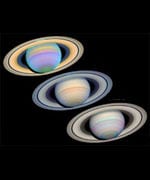Image credit: Hubble
The planet Saturn reached its maximum tilt towards the Earth last Spring, and astronomers took advantage of the situation to image the ringed planet in three wavelengths of light using the Hubble Space Telescope: ultraviolet, visible, and infrared. Saturn tilts at an angle of 26-degrees and experiences seasons in its hemispheres like the Earth as it travels around the Sun; its orbit takes nearly 30 years. Particles in Saturn's atmosphere reflect different wavelights of light differently, so the different images can help fill in pieces of missing information.
This is a series of images of Saturn, as seen at many different wavelengths, when the planet's rings were at a maximum tilt of 26 degrees toward Earth. Saturn experiences seasonal tilts away from and toward the Sun, much the same way Earth does. This happens over the course of its 29.5-year orbit. This means that approximately every 30 years, Earth observers can catch their best glimpse of Saturn's South Pole and the southern side of the planet's rings. Between March and April 2003, researchers took full advantage to study the gas giant at maximum tilt. They used NASA's Hubble Space Telescope to capture detailed images of Saturn's Southern Hemisphere and the southern face of its rings.
The telescope's Wide Field Planetary Camera 2 used 30 filters to snap these images on March 7, 2003. The filters span a range of wavelengths. "The set of 30 selected filters may be the best spectral coverage of Saturn observations ever obtained," says planetary researcher Erich Karkoschka of the University of Arizona. Various wavelengths of light allow researchers to see important characteristics of Saturn's atmosphere. Particles in Saturn's atmosphere reflect different wavelengths of light in discrete ways, causing some bands of gas in the atmosphere to stand out vividly in an image, while other areas will be very dark or dull. One image cannot stand by itself because one feature may have several interpretations. In fact, only by combining and comparing these different images, in a set such as this one, can researchers interpret the data and better understand the planet.
By examining the hazes and clouds present in these images, researchers can learn about the dynamics of Saturn's atmosphere. Scientists gain insight into the structure and gaseous composition of Saturn's clouds via inspection of images such as these taken by the Hubble telescope. Over several wavelength bands, from infrared to ultraviolet, these images reveal the properties and sizes of aerosols in Saturn's gaseous makeup. For example, smaller aerosols are visible only in the ultraviolet image, because they do not scatter or absorb visible or infrared light, which have longer wavelengths. By determining the characteristics of the atmosphere's constituents, researchers can describe the dynamics of cloud formation. At certain visible and infrared wavelengths, light absorption by methane gas blocks all but the uppermost layers of Saturn's atmosphere, which helps researchers discern clouds at different altitudes. In addition, when compared with images of Saturn from seasons past (1991 and 1995), this view of the planet also offers scientists a better comprehension of Saturn's seasonal changes.
Hubble News Release
 Universe Today
Universe Today
